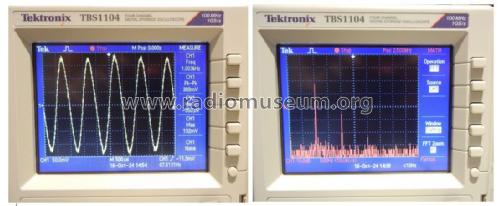- Pays
- Etats-Unis
- Fabricant / Marque
- Freed-Eisemann Radio Corp.; New York, NY
- Année
- 1925
- Catégorie
- Radio - ou tuner d'après la guerre 1939-45
- Radiomuseum.org ID
- 40946
Cliquez sur la vignette du schéma pour le demander en tant que document gratuit.
- No. de tubes
- 5
- Lampes / Tubes
- Principe général
- Récepteur TRF en général (avec ou sans réaction inconnu); Neutrodyne
- Circuits accordés
- 3 Circuits MA (AM)
- Gammes d'ondes
- PO uniquement
- Tension / type courant
- Piles (rechargeables ou/et sèches)
- Haut-parleur
- - Pour casque ou amplificateur BF
- Matière
- Boitier en bois
- De Radiomuseum.org
- Modèle: FE15 - Freed-Eisemann Radio Corp.;
- Forme
- Modèle de table boitier avec vouvercle
- Dimensions (LHP)
- 19 x 9.5 x 9.5 inch / 483 x 241 x 241 mm
- Remarques
- Three dials (primary tuning control knobs)
- Prix de mise sur le marché
- 75.00 $
- Source extérieure
- Ernst Erb
- Source du schéma
- Rider's Perpetual, Volume 1 = 1931/1934 (for 1919-1931)
- Littérature
- Collector's Guide to Antique Radios 4. Edition
- Schémathèque (1)
- Radio Manufacturers of the 1920's, Vol. 2
- D'autres Modèles
-
Vous pourrez trouver sous ce lien 205 modèles d'appareils, 106 avec des images et 128 avec des schémas.
Tous les appareils de Freed-Eisemann Radio Corp.; New York, NY
Collections
Le modèle FE15 fait partie des collections des membres suivants.
Contributions du forum pour ce modèle: Freed-Eisemann Radio: FE15
Discussions: 1 | Publications: 1
Receiver sensitivity was measured with Rohde & Schwarz SM300 signal generator with the adaptor for long wire antenna, connected to long wire antenna input of the radio.
The sensitivity is around -55 dBm at 1 MHz with a very good (S+N)/N ratio of more than 10 dB. The signal goes in the noise level at around -70 dBm. Even signals around -60 dBm still audible, with a reasonable (S+N)/N ratio. At 550 kHz the sensitivity is also -55 dBm, at 1200 kHz around -50 dBm and at more than 1300 kHz up to 1650 kHz around -45 dBm. The reduced sensitivity at higher frequency is related to the loss of selectivity (variation of variable capacitance versus the degree of rotation of tuning knobs).
RF Bandwidth
3 dB RF bandwidth is around 5 kHz, when perfectly tuned at middle of the BC band. Measurements were performed at 1 MHz, 1 kHz modulated signal, 75 % modulation index, -50 dBm input power at the long wire input connector. Please see the measurement photos.
Tuning can be very sharp. However, in order to increase the RF bandwidth, the tuning capacitors can be misaligned a bit, especially when listening the music. Very sharp tuned is recommended for voice only.
AF Distortions
The AM modulation uses 1 kHz tone, modulation index 75%. The oscilloscope, connected at the horn output display the demodulated signal. Measurements on the oscilloscope display shows also 1 kHz with a 0.3 % combined transmitted frequency and measurement error, as seen in the left oscilloscope screen photo.
Using the FFT function of the equipment we can measure that the 2nd harmonic is almost 25 dB lower than the fundamental tone, almost a perfect sinusoidal shape.
AF Bandwidth
The 6 dB AF bandwidth for sharp tuning is 1.4 kHz (500 Hz – 1900 Hz) and the cutting frequency is 3 kHz. The carrier and two side bands of AM is only around 4 kHz, and it is almost as wide as the 3dB RF bandwidth (5 kHz). Of course this has a big impact on the audition, the voice is advantaged versus the music.
This was normal in the horn speaker era when audio signals of more than 2.5 kHz were not reproduced properly.
Pièces jointes
Serioja Tatu, 26.Oct.24






























